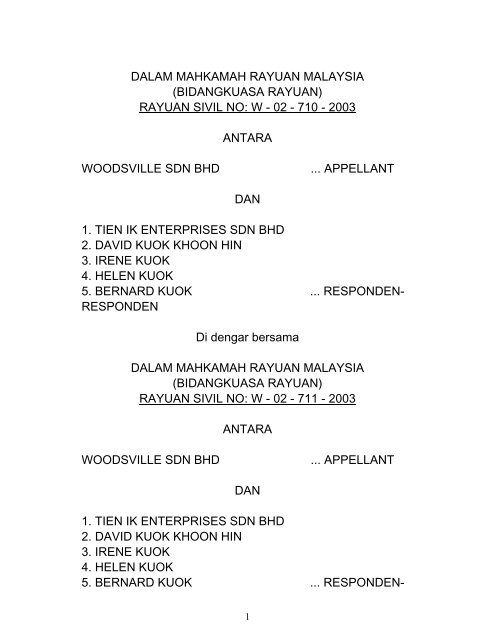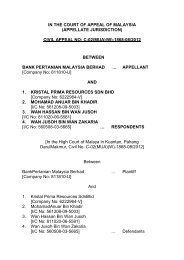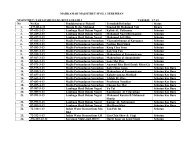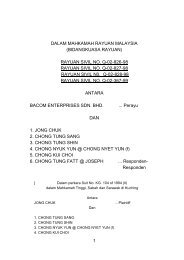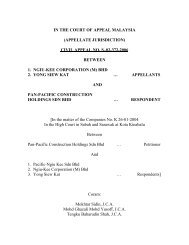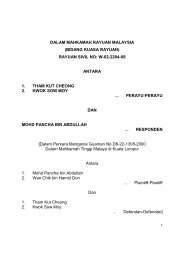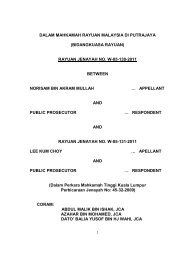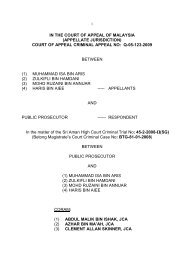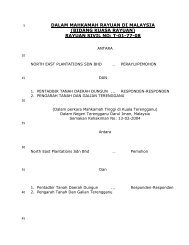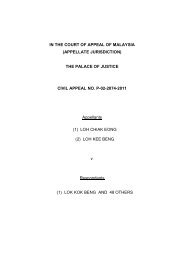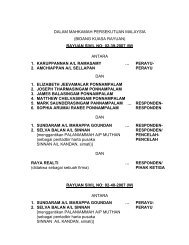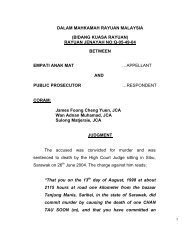DALAM MAHKAMAH RAYUAN MALAYSIA (BIDANGKUASA ...
DALAM MAHKAMAH RAYUAN MALAYSIA (BIDANGKUASA ...
DALAM MAHKAMAH RAYUAN MALAYSIA (BIDANGKUASA ...
You also want an ePaper? Increase the reach of your titles
YUMPU automatically turns print PDFs into web optimized ePapers that Google loves.
<strong>DALAM</strong> <strong>MAHKAMAH</strong> <strong>RAYUAN</strong> <strong>MALAYSIA</strong><br />
(<strong>BIDANGKUASA</strong> <strong>RAYUAN</strong>)<br />
<strong>RAYUAN</strong> SIVIL NO: W - 02 - 710 - 2003<br />
ANTARA<br />
WOODSVILLE SDN BHD ... APPELLANT<br />
DAN<br />
1. TIEN IK ENTERPRISES SDN BHD<br />
2. DAVID KUOK KHOON HIN<br />
3. IRENE KUOK<br />
4. HELEN KUOK<br />
5. BERNARD KUOK ... RESPONDEN-<br />
RESPONDEN<br />
Di dengar bersama<br />
<strong>DALAM</strong> <strong>MAHKAMAH</strong> <strong>RAYUAN</strong> <strong>MALAYSIA</strong><br />
(<strong>BIDANGKUASA</strong> <strong>RAYUAN</strong>)<br />
<strong>RAYUAN</strong> SIVIL NO: W - 02 - 711 - 2003<br />
ANTARA<br />
WOODSVILLE SDN BHD ... APPELLANT<br />
DAN<br />
1. TIEN IK ENTERPRISES SDN BHD<br />
2. DAVID KUOK KHOON HIN<br />
3. IRENE KUOK<br />
4. HELEN KUOK<br />
5. BERNARD KUOK ... RESPONDEN-<br />
1
RESPONDEN<br />
[<strong>DALAM</strong> <strong>MAHKAMAH</strong> TINGGI MALAYA DI KUALA LUMPUR<br />
(BAHAGIAN DAGANG)<br />
PENGGULUNGAN SYARIKAT NO. D2 - 28 - 187 - 1990<br />
Dalam Perkara Akta Syarikat, 1965<br />
Dan<br />
Dalam Perkara Tien Ik Enterprises Sdn Bhd<br />
Dan<br />
Dalam Perkara Seksyen 13, Akta Kehakiman 1964<br />
Dan<br />
Dalam Perkara Aturan 52 Kaedah 2(2) Kaedah-<br />
Kaedah Mahkamah Tinggi 1980<br />
Dan<br />
Dalam Perkara Notis Usul bagi mendapatkan<br />
kebenaran untuk memohon suatu Perintah atau<br />
Perintah untuk Komital<br />
ANTARA<br />
WOODSVILLE SDN BHD ... PEMPETISYEN<br />
DAN<br />
1, TIEN IK ENTERPRISES SDN BHD<br />
2, DAVID KUOK KHOON HIN<br />
3. IRENE KUOK<br />
4. HELEN KUOK<br />
5. BERNARD KUOK ... RESPONDEN-<br />
RESPONDEN]<br />
KORAM: Mohd Ghazali Mohd Yusoff, HMR<br />
Abu Samah Nordin, HMR<br />
Sulaiman Daud, HMR<br />
2
JOINT JUDGMENT OF MOHD GHAZALI MOHD<br />
YUSOFF, ABU SAMAH NORDIN AND SULAIMAN<br />
DAUD, J.J.C.A.<br />
1. There are two appeals before the court. The appeals are<br />
against the decision of Zainun Ali J (as she then was) in<br />
allowing the applications of the liquidator of Tien Ik<br />
Enterprises Sdn Bhd, the 1 st respondent and David Kuok<br />
Khoon Hin, the 2 nd respondent to set aside an ex-parte order<br />
granting leave to apply for issue of order of committal against<br />
them.<br />
The background<br />
2. The 1 st respondent was wound up on 9 June 1994 under<br />
section 218(1)(i) of the Companies Act 1965 (“the Act”) vide<br />
Winding-Up Petition No. D2-28-187-1990 presented by<br />
Woodsville Sdn Bhd, i.e., the appellant.<br />
3. Pursuant to the aforesaid winding-up order, Gong Wee<br />
Ning (hereafter referred to as “the liquidator”) was appointed<br />
as one of the liquidators for the 1 st respondent.<br />
4. On 10 August 1998 the appellant filed an application for an<br />
order to remove the liquidator (hereafter referred to as “the<br />
removal application”). One of the grounds raised by the<br />
appellant to support the removal application was on an<br />
allegation that the liquidator has failed to carry out a proper<br />
3
investigation in relation to the 1 st respondent’s beneficial<br />
ownership of three pieces of land, the particulars of which are<br />
as follows -<br />
(a) Certificate of Title No 8864;<br />
(b) Lease of State Land Title No 1395; and<br />
(c) Lease of State Land Title No 1020;<br />
(hereafter referred to as “the Tuallang lands”) which were<br />
then registered in the name of a locally incorporated company<br />
known as Tanjong Tin Dredging Malaysia Sdn Bhd (“TTDM”).<br />
At the material time the 1 st respondent owned all the shares<br />
of TTDM.<br />
5. The removal application was dismissed by the Court on 31<br />
May 2000 and is now pending appeal before this court.<br />
6. On 20 April 2001, the appellant filed an ex-parte<br />
application pursuant to Order 52 rule 2 of the Rules of the<br />
High Court 1980 (“the Rules”) for leave for issue of committal<br />
proceedings against the liquidator and David Kuok Khoon<br />
Hin, i.e., the 2 nd respondent (hereafter referred to as “David<br />
Kuok”) who was at the material time a member of the<br />
committee of inspection appointed to act with the liquidator,<br />
for their failure to disclose and or concealing to the Court the<br />
existence of the 1 st respondent’s beneficial interest in the<br />
Tuallang lands.<br />
4
7. The grounds of the application for leave for issue of<br />
committal proceedings were that the liquidator and David<br />
Kuok have affirmed affidavits, either personally and or on<br />
their behalf and filed in the removal application, wherein they<br />
stated that the 1 st respondent has no beneficial interest in the<br />
Tuallang lands. It is alleged that the statements made by<br />
each of them were untrue and that they knew and or ought to<br />
have known as untrue. It is further alleged that the liquidator<br />
and David Kuok failed to disclose the true position of the<br />
Tuallang lands in the removal application even after they<br />
found out the existence of the Tuallang lands and that the<br />
beneficial interest of the same vest in the 1 st respondent. It is<br />
finally alleged that the liquidator had committed contempt of<br />
court by failing to conduct any investigation on the existence<br />
of the Tuallang lands.<br />
8. The application for leave sought for issue of committal<br />
proceedings against the liquidator and David Kuok was<br />
allowed by the learned judge on 22 June 2001.<br />
9. On 6 August 2001, the liquidator filed an application by<br />
way of notice of motion (enclosure 230) to set aside the said<br />
ex-parte order granted against him. Subsequently on 11<br />
October 2001 David Kuok made a similar application<br />
(enclosure 236). Both applications to set aside the said exparte<br />
orders were allowed by the learned judge on 24 July<br />
2003 and hence, these appeals.<br />
5
10. In allowing the liquidator’s application to set aside the said<br />
ex-parte order, the learned judge said that following Zainal<br />
Abidin Puteh & Anor v Chen Wan Development Sdn Bhd<br />
[1992] 2 MLJ 233, “there has to be leave of Court before<br />
proceeding against liquidators and receivers” and that this<br />
requirement “cannot be ignored since these are officers of the<br />
court”. As the appellant has not obtained such leave, the<br />
learned judge allowed the liquidator’s application and set<br />
aside the said ex-parte order against him.<br />
11. The learned judge’s grounds for allowing David Kuok’s<br />
application to set aside the said ex-parte order against him<br />
were as follows -<br />
(a) David Kuok did not affirm any affidavit in the removal<br />
application; the only affidavit that was filed was affirmed by<br />
one Cyril Gomez on behalf of David Kuok and the 3 rd to the<br />
5 th respondents (who are not parties to these appeals);<br />
(b) Cyril Gomez did not in his affidavit make any positive<br />
averment that TTDM did not own the Tuallang lands and that<br />
“this omission is not quite the same as it being a positive<br />
assertion of this fact”; and<br />
(c) there is also non-disclosure of material facts by the<br />
appellant, namely, the appellant did not inform the Court that<br />
6
it has filed an appeal to this court in relation to the removal<br />
application.<br />
Civil Appeal No. W-02-710-2003<br />
12. Before us, learned counsel for the appellant argued that<br />
the learned judge erred in law in deciding that the appellant<br />
was required to initiate a separate and distinct leave<br />
application from the Court before filing the ex-parte<br />
application for leave for issue of committal proceedings<br />
against the liquidator.<br />
13. Counsel for the appellant contended that since the<br />
committal proceeding is an ancillary proceeding which<br />
originate from the pre-existing proceedings filed in Court, the<br />
appellant is not required by law to file a separate leave<br />
application for the purposes of initiating committal<br />
proceedings against the liquidator. Counsel then argued that<br />
the contempt committed by the liquidator arose in his capacity<br />
as a deponent of an affidavit and not in his official capacity<br />
as liquidator for the 1 st respondent. He submitted that section<br />
236(3) of the Act which was discussed in Chi Liung Holdings<br />
Sdn Bhd v Ng Pyak Yeow [1995] 3 MLJ 204 is not applicable<br />
in this case. Section 236 of the Act provides for powers of<br />
liquidator and section 236(3) reads -<br />
“The exercise by the liquidator of the powers conferred by this<br />
section shall be subject to the control of the Court, and any creditor<br />
or contributory may apply to the Court with respect to any exercise or<br />
7
proposed exercise of any of those powers.”<br />
Counsel argued that section 236(3) of the Act has no bearing<br />
on the appeal before us. He contended as follows -<br />
“This present appeal is not brought against the Liquidator in respect<br />
of the exercise of his powers under Section 236. Rather, it is brought<br />
against the Liquidator for filing misleading affidavits in the Appellant’s<br />
Removal Application and also deliberately (as admitted by him, albeit<br />
legal advice) suppressing evidence (by refusing to inform the<br />
Honourable High Court on his discovery that the Tuallang Lands<br />
were beneficially owned by the 1 st Respondent). The issue of the<br />
existence and ownership of the Tuallang Lands was very much a live<br />
issue in the Removal Application.”<br />
14. In the course of canvassing his arguments, counsel for<br />
the appellant referred to the case of In re Maidstone Palace<br />
of Varieties, Limited. Blair v Maidstone Palace of Varieties,<br />
Limited [1909] 2 Ch 228 and contended that leave of the<br />
winding-up court is required only when the proposed action<br />
against a liquidator is pursued in another court other than the<br />
winding-up court. In that case Neville J said (at page 286)<br />
that the court “will not allow its officers to be subject to an<br />
action in another court with reference to his conduct in the<br />
discharge of the duties of his office, whether right or wrong”.<br />
His grounds of judgment reads -<br />
“In this case the applicant is a receiver appointed by this Court in a<br />
debenture-holders’ action, and by virtue of that appointment he has<br />
had the management of the theatre known as the Maidstone Palace<br />
8
of Varieties. In the course of that management he made use of<br />
certain plant which is claimed by the respondent company as their<br />
property. They say that he had no right to use it except on the terms<br />
of paying them a rent, and they claim a considerable sum. It appears<br />
to me that a dispute of that kind is one which, as is shewn by Aston v<br />
Heron (2 My & K 890), the Court will deal with itself, and that it will<br />
not allow its officer to be subject to an action in another Court with<br />
reference to his conduct in the discharge of the duties of his office,<br />
whether right or wrong. The proper remedy for any one aggrieved by<br />
his conduct is to apply to this Court in the action in which he was<br />
appointed. If any wrong has been done by the officer, the Court will<br />
no doubt see that justice is done, but no one has a right to sue such<br />
an officer in another Court, without the sanction of this Court. The<br />
present application is accordingly right in form. The respondents<br />
must therefore bring in their claim in the debenture-holders’ action<br />
within fourteen days, and must be restrained from commencing any<br />
other proceedings against the receiver.”<br />
15. In opposing the appeal, learned counsel for the liquidator<br />
contended, inter alia, that leave is required not only when<br />
misconduct of a liquidator is in issue but in any proceeding<br />
against a liquidator who is an officer of the Court. To support<br />
his contention counsel referred to the case of Zainal Abidin<br />
Putih, supra. In that case, the respondent had obtained an<br />
order against the Co-operative Central Bank Bhd (“CCB”) for<br />
the return of documents of titles of properties charged and for<br />
costs. The respondent consequently brought an action<br />
against the appellants, who had been appointed the<br />
receivers of CCB, for payment of the costs of the first action.<br />
The learned judge of the High Court ordered the appellants to<br />
9
pay the said costs. The appellants appealed. In the allowing<br />
the appeal, the Supreme Court held that the appellants were<br />
appointed receivers by the High Court and as officers of the<br />
court, leave of the court should have been obtained to<br />
proceed against them in the court action. In delivering the<br />
judgment of the court, Gunn Chit Tuan SCJ (as he then was)<br />
said (at page241) -<br />
“We would start off by pointing out that the appellants were<br />
appointed receivers by the court and are therefore first and foremost<br />
officers of the court, and to use the words of Viscount Haldane LC in<br />
William H Parsons & Ors v The Sovereign Bank of Canada ([1913]<br />
AC 160) ‘put in to discharge certain duties prescribed by the order<br />
appointing him’. In the present case, the appellants were appointed<br />
by the High Court under sub-para (c) of para (1) of reg 9 of the<br />
Essential (Protection of Depositors) Regulations 1986, which reads<br />
as follows:<br />
... to manage the affairs and property of the deposit-taker<br />
and for such incidental or ancillary orders or directions in<br />
relation to such appointment as may, in the opinion of the<br />
Central Bank, be necessary or expedient;<br />
The deposit-taker in this case, ie the Co-operative Central Bank Bhd,<br />
remains in existence but has lost its title to control its assets and<br />
affairs. As the appellants were appointed by the court and are<br />
responsible to it and cannot obey the directions of the parties in the<br />
action, they do not stand in the position of agents to the parties who<br />
are interested at the suit of whom they are appointed (Corporation of<br />
Bacup v Smith ((1890) 44 Ch D 395) at p 398 per Chitty J). But the<br />
important point in this case was that as the appellants are officers of<br />
the court, leave of the court should have obtained to proceed gainst<br />
10
them in the second originating summons and the case of Re<br />
Maidstone Palace of Varieties Ltd (([1909] 2 Ch 283) was correctly<br />
cited by counsel for the appellants in support of his submission that<br />
leave of the court was necessary. Unfortunately the preliminary<br />
objection of counsel in the lower court was overruled by the learned<br />
judge for if his Lordship had upheld that preliminary objection, then<br />
the further prosecution of the second originating summons should<br />
have been restrained and dismissed with costs if leave was not<br />
obtained.”<br />
16. Counsel for the liquidator also referred to Chi Liung<br />
Holdings Sdn Bhd, supra, a decision of this court. In that<br />
case, a company had signed a tenancy agreement with the<br />
applicant in respect of certain premises. The agreement<br />
provided the company with an option to purchase in the event<br />
that the owner intends to sell the premises. Subsequently, the<br />
company gave notice of its intention to exercise the option but<br />
the applicant did not immediately respond. Consequently the<br />
applicant gave notice to the company to vacate the premises<br />
by 1 August 1989. By that time, there was already a petition<br />
filed to wind up the company. On 19 December 1989, the<br />
liquidator handed over the premises to the applicant. The<br />
applicant is now claiming arrears of rental from the liquidator.<br />
The liquidator, in turn, claimed the refund of deposit.<br />
17. The issue before the trial court was whether the applicant<br />
was entitled to forfeit the deposit towards payment of the<br />
arrears of rental and whether the applicant could claim for the<br />
arrears from the liquidator. The Court dismissed the<br />
11
applicant’s originating motion because section 226(3) of the<br />
Act which provides for obtaining leave of the court had not<br />
been complied with. The applicant appealed to this court.<br />
Section 226(3) of the Act reads -<br />
When a winding up order has been made or a provisional liquidator<br />
has been appointed no action or proceeding shall be proceeded with<br />
or commenced against the company except -<br />
(a) by leave of the Court; and<br />
(b) in accordance with such terms as the Court imposes.<br />
The issue before this court was whether leave of the Court<br />
was necessary before the applicant could commence his<br />
originating motion against the liquidator personally. This court<br />
agreed with the trial judge that the originating motion required<br />
the leave of the Court before it could be brought, but not for<br />
the reasons found by the trial judge. This court held that<br />
under section 236(3) of the Act (reproduced earlier) it is clear<br />
that the liquidator, having been appointed by the court, is an<br />
officer of the court and thus leave of the court is needed<br />
before an action is commenced against him and officers like<br />
him. In delivering the judgment of this court, Abu Mansor Ali,<br />
JCA said (at pages 2635-2636) -<br />
“We would cite the legal position of receivers who are in the same<br />
position as officers of court. In the text book the LAW RELATING TO<br />
RECEIVERS, MANAGERS AND ADMINISTRATORS by Hubert<br />
Picarda at p 339 the learned author wrote:-<br />
12
‘A receiver, in the words of Viscount Haldane LC, ‘is an<br />
officer of the Court put in to discharge certain duties<br />
prescribed by the order appointing him’. ... He is ‘nothing<br />
more than the hand of the Court’. ... for the purpose of<br />
holding the property of the litigants, ... and the possession of<br />
the Receiver is simply the possession of the Court.’<br />
Then at p 373 of the textbook LAW OF RECEIVERS by PS<br />
Atchuthen Pillai 2 nd Edition the author wrote in para 27:<br />
‘27. Suit without leave is contempt of court and will be<br />
dismissed. A suit against a receiver when filed without leave<br />
of court is liable to be dismissed...<br />
Institution of proceedings against a receiver without leave of<br />
the court is contempt of court. It is incompatible with the<br />
dignity and authority of the court to allow its officer to be<br />
summoned before any tribunal...’<br />
As we have stated we were unanimous that the applicant should<br />
have obtained leave before making his application below, for the<br />
attitude of a winding up court has been that some form of leave is<br />
required.”<br />
The learned judge then said (at page 2640) -<br />
“While we agree that the applicant may proceed against the<br />
liquidator, we are however, firmly of the view the procedure is that<br />
the applicant must have first obtained authority from the winding up<br />
judge before proceeding against the liquidator and not, as was done<br />
here, proceeded independently to prevent unnecessary and wasteful<br />
litigation.”<br />
13
18. We would agree with the submission of learned counsel<br />
for the liquidator. Upon perusing the authorities referred to<br />
earlier, we are of the unanimous view that prior leave from<br />
the Court is required before the appellant can make any<br />
application for leave under Order 52, rule 2 of the Rules as<br />
against the liquidator, he being an officer of the court. It is<br />
clear that the appellant was not armed with such leave when<br />
he made the application against the liquidator.<br />
19. As discussed earlier, learned counsel for the appellant in<br />
referring to In re Maidstone Palace of Varieties, Limited<br />
argued that leave of the winding-up court is required only<br />
when the proposed action against a liquidator is pursued in<br />
another court other than the winding-up court. We do not<br />
agree with counsel’s proposition. Whether the purported<br />
action against the liquidator is in another court or the windingup<br />
court is irrelevant. In the instant case the appellant alleged<br />
that the liquidator has committed contempt of court by failing<br />
to conduct any investigation on the existence of the Tuallang<br />
lands as a result of which it is initiating committal proceedings<br />
against the liquidator in the course of the winding-up of the 1 st<br />
respondent. The liquidator has yet to be released or has yet<br />
to apply to court for an order that he be released and that the<br />
company be dissolved. Pending that, he is still an officer of<br />
the court and any proposed action against him by the<br />
petitioner as in this case for any alleged wrongdoing will still<br />
need the sanction of the winding-up court. As such, we are of<br />
14
the view that the learned judge was correct in setting aside<br />
the said ex-parte order obtained against the liquidator. On<br />
this ground alone, we would dismiss the appeal by the<br />
appellant with costs. We would also order that the deposit be<br />
remitted to the liquidator to account of taxed costs.<br />
Civil Appeal No. W-02-711-2003<br />
20. This appeal is against the decision of the learned judge in<br />
allowing the application of David Kuok to set aside the said<br />
ex-parte order obtained against him pursuant to Order 52,<br />
rule 2 of the Rules as discussed earlier. It is common<br />
ground that the issue of any requirement for separate leave<br />
as in the case of the liquidator does not arise here.<br />
21. In canvassing this appeal, learned counsel for the<br />
appellant contended that at all material times, David Kuok<br />
was fully aware of the 1 st respondent’s beneficial interest in<br />
the Tuallang lands. He also pointed out that David Kuok was<br />
fully appraised of the removal application and that one of the<br />
grounds relied by the appellant in that application was David<br />
Kuok’s failure to carry out investigations into the ownership of<br />
the Tuallang lands.<br />
22. With regards to the issue raised by David Kuok that he<br />
never affirmed any affidavit in opposing the removal<br />
application, counsel for the appellant pointed out that in the<br />
affidavit affirmed by Cyril Gomez, the latter stated that he was<br />
15
duly authorised to affirm the affidavit on behalf of the 2 nd to<br />
the 5 th respondents; that would include David Kuok. Counsel<br />
then submitted that in his affidavit, Cyril Gomez categorically<br />
adopted the averments made by the liquidator who denied<br />
the appellant’s assertion as to the existence and beneficial<br />
ownership of the Tuallang lands by the 1 st respondent.<br />
Counsel argued that it is trite that a person who authorises a<br />
deponent to affirm an affidavit on his behalf is bound by the<br />
contents of such an affidavit and by reason of the aforesaid,<br />
David Kuok is bound by the contents of the affidavit affirmed<br />
by Cyril Gomez in opposing the removal application.<br />
23. Counsel for the appellant further pointed out that it is<br />
pertinent to note that during the course of the removal<br />
application, David Kuok did not make any attempt to correct<br />
the averments made by Cyril Gomez in the latter’s affidavit<br />
and to disclose to the Court that the Tuallang lands were<br />
beneficially owned by the 1 st respondent even though David<br />
Kuok was fully aware that the existence and ownership of the<br />
Tuallang lands was a live issue in the removal application.<br />
Counsel then submitted that David Kuok’s contention that he<br />
did not mislead the Court on the ground that the offending<br />
affidavit was filed by Cyril Gomez is totally misconceived as<br />
David Kuok was fully aware that the Court was considering<br />
the issue of ownership of the Tuallang lands to determine<br />
whether there was misconduct by the liquidator.<br />
16
24. Counsel for the appellant concluded that David Kuok’s<br />
decision not to disclose this vital information, viz., the<br />
existence and ownership of the Tuallang lands before the<br />
delivery of the decision on the removal application is a<br />
deliberate obstruction of justice and a calculated act to<br />
demean the integrity of the Court which is tantamount to<br />
misconduct in the face of the Court and therefore David Kuok<br />
has committed contempt of court.<br />
25. In opposing this appeal, learned counsel for David Kuok<br />
submitted that if all the cause papers relating to the removal<br />
application were disclosed in the said ex-parte application for<br />
leave, the facts would show that there is no prima facie<br />
evidence of contempt against David Kuok. Counsel then<br />
referred to the case of Edmund Ming Kwan @ Kwaun Yee<br />
Ming, Edmund v Extra Excel (Malaysia) Sdn Bhd & Ors (Part<br />
2) [2007] 7 MLJ 276. That case relates to an application by a<br />
petitioner in a petition presented under section 181 of the Act<br />
for leave to make an application for an order of committal for<br />
contempt of court against the 2 nd and 4 th respondents on the<br />
grounds that the 2 nd respondent had willfully and intentionally<br />
made false and misleading statements in his affidavits and<br />
against the 4 th respondent for affirming an affidavit wherein<br />
he adopts the contents of the 2 nd respondent’s affidavits and<br />
for authorizing the 2 nd respondent to affirm certain affidavits.<br />
In dismissing the application, Vincent Ng J (as he then was)<br />
said (at pages 280-281) -<br />
17
“On the question whether the statement was intended to be false and<br />
misleading (mens rea) and whether it was made with actual or<br />
inevitable intent or consequence of frustrating or obstructing the<br />
administration of justice, the court would have to: (i) firstly, look at the<br />
relationship between the alleged false statements and the issues to<br />
be decided in the main proceedings (see Keeley b Brooking [1979]<br />
25 ALR 45); (ii) secondly, bear in mind that unlike the offence of<br />
perjury, contempt requires the actual or inevitable intent or<br />
consequence of frustrating or obstructing the administration of justice<br />
(see Jaginder Singh & Ors v Attorney-General [1983] 1 MLJ 71,<br />
Coward v Stapleton [1953] 90 CLR 573, Re Bride, Ex-parte Steward<br />
[1948] WB 455, R v Christopher Charles Murfett [2004] VSC 160 and<br />
Halsbury’s Laws of England, 4 th Ed Vol 9(1) pp 242-243; (iii) thirdly,<br />
be mindful that a ‘mere falsity of evidence is not enough to justify a<br />
contempt charge’ (see Yee Sang Metal [2002] HKCU 1255); and,<br />
(iv) fourthly, be slow to draw inferences from affidavits as to the bona<br />
fides or mala fides of the alleged contemnor (see in Re Smith and<br />
Fawcett Ltd [1942] CH 304.“<br />
26. Counsel for David Kuok pointed out that the appellant<br />
had, in paragraph 4.1.5 of its Statement pursuant to Order 52<br />
rule 2(2) of the Rules filed in the course of the ex-parte<br />
application for leave for issue of order of committal, alleged<br />
as follows -<br />
“Even assuming that the 2 nd Respondent had only discovered the<br />
Tuallang lands in October and or November 1998 (which is denied),<br />
the 2 nd Respondent failed and or omitted to disclose to this<br />
Honourable Court the existence of the Tuallang lands and to file an<br />
affidavit at the earliest opportunity correcting his earlier position that<br />
such lands did not exist. The fact is that the 2 nd Respondent did not<br />
18
disclosed to or concealed from the Liquidator and to this Honourable<br />
Court that TTDM belongs to the Company and that he and or with<br />
other Respondents continue to control and manage the same.”<br />
27. Counsel for David Kuok then submitted that following the<br />
case of Edmund Ming Kwan, supra, the relationship of the<br />
alleged false statement and the issues to be decided in the<br />
removal application has to be considered. However, he<br />
pointed out that David Kuok did not affirm any affidavit in the<br />
removal application. He also pointed out that the impugned<br />
affidavit was affirmed by Cyril Gomez for and on behalf of not<br />
only David Kuok but also for the 3 rd to the 5 th respondents.<br />
Further, Cyril Gomez did not make any averment that TTDM<br />
did not own the Tuallang lands and hence there was nothing<br />
to correct. As such, counsel submitted that it is fallacious to<br />
suggest that Cyril Gomez or David Kuok through Cyril Gomez<br />
confirmed the non-existence of the Tuallang lands.<br />
28. In conclusion counsel submitted that the said ex-parte<br />
order for leave to commence committal proceedings against<br />
David Kuok were devoid of evidence and merits and hence<br />
the learned judge was right to have set aside the order that<br />
she granted.<br />
29. We agree with the submission of learned counsel for<br />
David Kuok. We find that the appellant has failed to show that<br />
he has a prima facie case against David Kuok to justify the<br />
19
Court to grant leave pursuant to Order 52 rule 2 of the Rules.<br />
We do not think that the alleged omission in the affidavit of<br />
Cyril Gomez in relation to the Tuallang lands and which<br />
affidavit was made, inter alia, on behalf of David Kuok would<br />
be enough to justify a contempt charge or even be sufficient<br />
to draw inferences against David Kuok. We fully adopt the<br />
requirements that have to be considered by the court in<br />
determining the question as to whether a statement was<br />
intended to be false or misleading and whether it was made<br />
with actual or inevitable intent or consequence of frustrating<br />
or obstructing the administration of justice as summarised by<br />
Vincent Ng J in Edmund Ming Kwan, supra.<br />
30. We find no merits in this appeal. We are of the view that<br />
the learned judge was correct in setting aside the ex-parte<br />
order for leave against David Kuok. Order 32 rule 6 of the<br />
Rules provides that the Court may set aside an order made<br />
ex-parte. We find that the learned has exercised her<br />
discretion judiciously and hence find no reason to disturb her<br />
decision. As such, we hereby dismiss this appeal with costs<br />
and order that the deposit be remitted to the 2 nd respondent<br />
to account of taxed costs.<br />
Dated this 26 th day of February 2009<br />
20
Mohd Ghazali Mohd Yusoff<br />
Judge, Court of Appeal<br />
Malaysia<br />
Abu Samah Nordin<br />
Judge, Court of Appeal<br />
Malaysia<br />
Sulaiman Daud<br />
Judge, Court of Appeal<br />
Malaysia<br />
Counsel<br />
For the Appellant: Lim Kian Leong<br />
Ong Chee Kwan<br />
Tan Keng Teck<br />
Tetuan Lee Ong & Kandiah<br />
For the 1 st Respondent: Tan Hock Chuan<br />
Cains Tan<br />
Tetuan Tan Hock Chuan & Co<br />
For the 2 nd Respondent: M. Nagarajah<br />
Sudesh Singh<br />
Tetuan Shook Lin & Bok<br />
21


